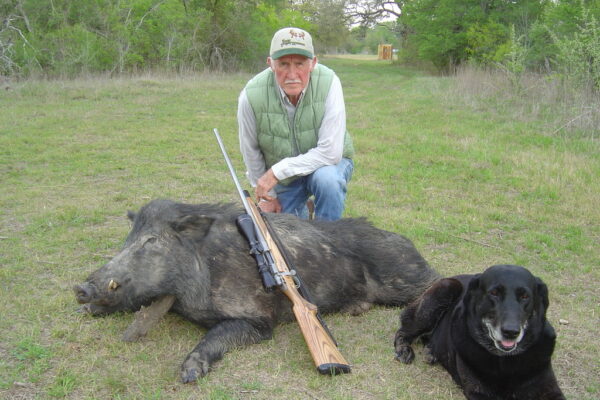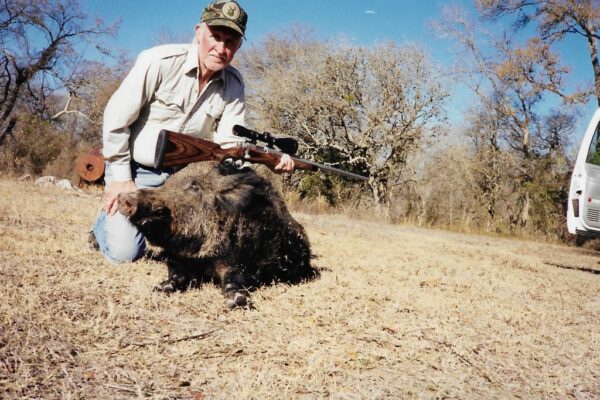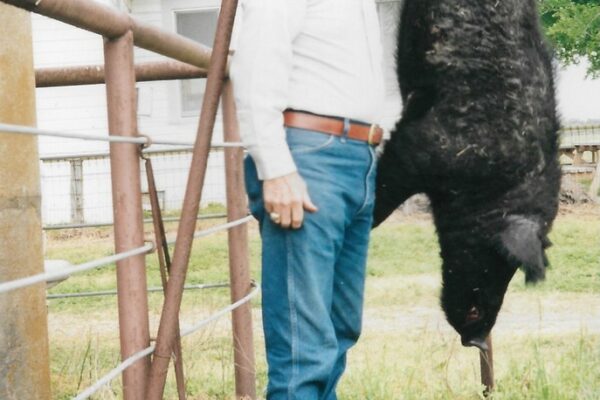By: Horace Gore
Hog hunting has become popular in Texas for several reasons. For one, we have a lot of feral hogs, and two, most landowners will let responsible hunters hunt hogs when such hunts don’t interfere with other hunting such as deer and turkey. Many deer hunters have access to hogs on their lease. If you are new to hogs, I will try to help you with your hog hunting.
First, you need to know about two types of wild hogs in Texas. The majority are “feral” hogs—hogs that have developed from domestic hogs gone wild. Most feral hogs are spotted, have curly tails, and are physically shaped like a domestic hog—big ears, short snout, with the hind end about as heavy as the front end. These hogs will come repeatedly to a feeder, even when they are shot at every time they show up.
A few areas in Texas have “Russian”-type hogs brought in from eastern states like Arkansas, Tennessee, and Georgia, where they have been running wild for 100 years. These hogs are a solid color—black, red or gray—big at the shoulder and little at the hip, have long, straight tails, long snouts, and very thin hair that is long down the center of the back from head to tail. The longer back hairs are split, and older boars have a thick shoulder pad and long tusks. You may not see these hogs for a week, after they have been shot at near a feeder.
I can think of three or four popular ways for hunting hogs. You can hunt them safari-style by driving roads in hog country and shooting them on sight. This can be exciting, but not very productive because a lot of the hogs will be moving and hard to hit. Safari hunting can be improved by corning the roads before you hunt, and the best time is early morning or late evening. Calibers such as .270; .30-06; and .300 Mag. are best, and the .243 and 6mm are minimum.
If your hog hunting country has a few straight roads, a good way to hunt is to corn a 200- to 300-yard stretch of road where hogs are known to roam. The best time to hunt is an hour before dark or at daylight. Place yourself midway in the stretch of corned road and watch both directions. Use a good scoped rifle with plenty of punch to keep a hog down.
Deer hunters often have good opportunities to hunt hogs at corn feeders. Feral hogs come to feeders regularly, and hunters have a good chance to get one or two before they flee from the scene. This is a very productive way to hunt and kill one or two hogs at a time. Deer rifles and ammo from .243 on up are sufficient for shooting hogs at feeders.
Some parts of Texas have a lot of hog hunters who use dogs to find and bay hogs for the hunter’s gun or knife. These hunts can be exciting, dangerous from both bad hogs, and hunters with guns, and can sometimes get long and hard when an old boar will not stop and fight. Hog hunting with dogs is not for the faint-hearted. Guns for such hunts are the short-barreled .30-30, the .44 Mag., and other big calibers. The smart hunter who uses dogs will leave the pistol at home. It is dangerous enough with short-barreled rifles.
The best way to kill or cripple a lot of hogs is with a helicopter and a shooter with a 12-gauge shotgun and 00 or 0 buckshot. Farmers and ranchers who have depredating hogs can eliminate a lot of hogs in this manner. But this is not hog hunting. This is hog shooting for a distinct purpose—to get rid of hogs.
For the hog hunter who is interested in saving some meat from the hunt, there are several ways to salvage meat if you are lucky enough to find and retrieve a hog. Don’t expect to put your hands on many hogs unless you have a trailing dog. Big hogs often run, even when shot with big caliber guns, unless the shot is in the front end of the hog and puts the hog down quickly. A wounded hog is hard to find without a dog because they do not leave a good blood trail like a deer.
Backstraps of a good eating hog can be cut out by placing the hog on its belly and cutting through skin near the backbone from the shoulder to the hip. Pull the backstrap away from the bone and peel it out on each side of the backbone. Carry a plastic bag to carry the meat.
If you kill a big hog, especially a boar, and you wonder if it is good to eat, try this: With a long knife—with a 3- or 4-inch blade—push the blade as deep as you can into the hip while the hog is still warm. Stick your index finger as deep as you can into the cut, and leave it to a count of 10. Quickly remove your finger and smell it. If it smells like old boar, leave it. If it smells like hot hog meat, the hog is good. Gut and skin it as quick as you can.
One of the best ways to cook hog shoulders, or a hindquarter is to place both shoulders, or one boned hindquarter in a big roaster pan. Salt and pepper as needed and cover half-up the meat with Classic Coke. Cover and cook 2 ½-3 hours in center oven at 325 degrees. Cool and remove the meat from the bone. Good for sandwiches.






